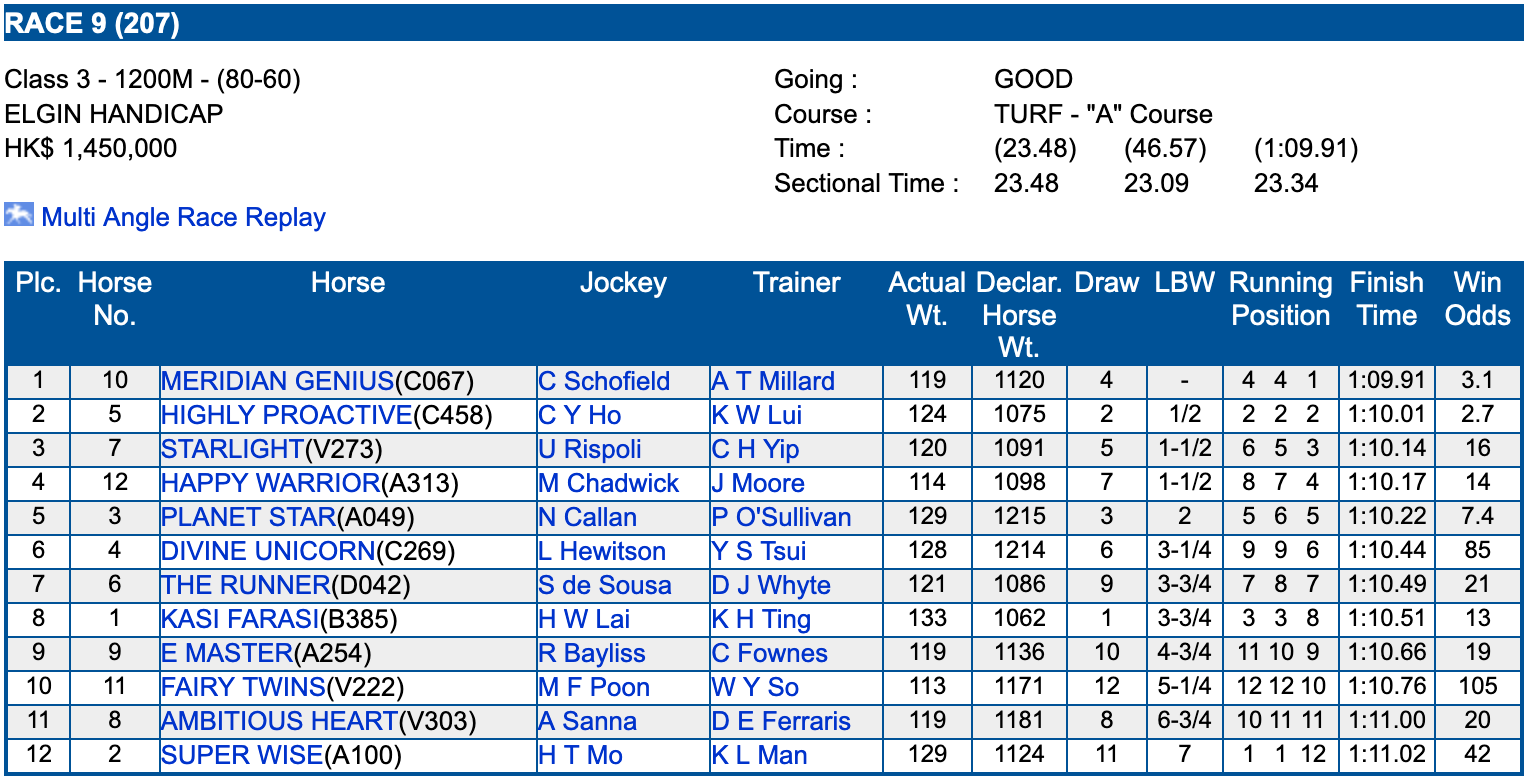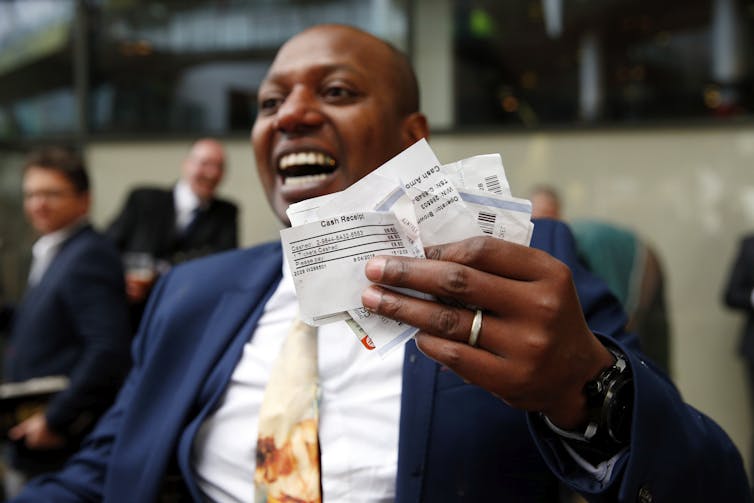Hello and Happy New Year to everyone! You must have noticed my slow to non-existing pace of publishing articles on this blog recently. With the World Cup and the hot summer around, I must admit there were better things to do than writing for my blog. The start of the football season didn’t make things better, since betting turns out to be significantly more profitable than writing about betting, so with hobby time being scarce the choice for me was clear. Luckily, I have rediscovered my passion for writing, by coming across a great story that I thought I should share with you. Today we talk about Bill Benter and his algorithm for beating the racetrack.
- Bill Benter Book
- William Benter Horse Racing Paper
- Bill Benter Gambler
- William Benter Horse Racing Software
- Bill Benter Horse Racing Algorithms
I have just recently read a very nice and thorough article in Bloomberg Businessweek about Bill Benter, the godfather of horse race betting and one of the most successful punters in the history of gambling. This inspired me to dig a bit deeper into Bill Benter’s work and share my findings with you.
Who is Bill Benter?
Bill Benter was a Vegas card counter turned professional horse racing handicapper. Armed with a strong quantitative background and endless dedication, he was determined to develop a successful betting algorithm and beat the Hong Kong racetracks. While doing so Benter went bankrupt once, needing to return to the United States to look for new financing and got ditched by his business partner. That didn’t stop him and he continued to work on his model, until he finally had an algorithm which secured him substantial returns on the racetrack. It’s a fantastic story of dedication and comeback, involves some of the biggest names in the history of gambling and I strongly recommend reading the whole article in Bloomberg.
William Benter (Bill Benter), Horse Racing Legend Born and raised in Pittsburgh, Pennsylvania, William Benter began using his mathematics skills to count cards. Legend has it that in the mid 1970s Benter came across the book “Beat the Dealer”, memorized it’s strategies and began his professional gambling career at the blackjack tables of. The Gambler Who Cracked the Horse-Racing Code Bill Benter did the impossible: He wrote an algorithm that couldn’t lose at the track. Close to a billion dollars later, he tells his story for the.
Apparently, after having made it on the racetrack, Bill Benter has retired from gambling, turned to philanthropy and decided to share with the world some of his secrets. He did so by publishing the self-authored paper “Computer Based Horse Race Handicapping and Wagering Systems: A Report”, which has since turned into a classic for all aspiring professional punters.
Can I put it to use?
The report is certainly no ticket for millionaire town, even if you do grasp the mathematical details of it, which depending on your prior knowledge might take you some time. After all, Bill Benter has written it in 1995, more than 20 years ago. There has certainly been a myriad of much more sophisticated and advanced models written in the meantime, which could easily beat Bill Benter‘s model on the racetrack. Nevertheless, I have found the model very elegant in its basics and believe there is something to learn from it for anyone. Furthermore, even if the paper itself does not guarantee you an edge on the racetrack, it certainly represents a very solid foundation for a model, which you can build upon.
Bill Benter’s paper represents the rare case of a sharp punter sharing some of his methods so it is certainly worth a detailed read. It is a prime example of a Fundamental Value Betting strategy that beats the market. And since most of us are quite busy, below I give you a summarized review with (what I thought were) the most intriguing parts of it.
Bill Benter’s Model
So what is this model all about?
The author tests the hypothesis that a fundamental approach to empirically assessing each horse’s chance of winning can find profitable wagering opportunities.
Trying to invent the perfect model for the racetrack, Benter started digging at data and discovering all the possible factors influencing the outcome of a horse race, which he then combined in a multinomial logit model. Those ranged from the more obvious ones (horse’s form based on its finishing position in previous races) to the more exotic ones, like preferred surface and weather conditions. After many hours of work Bill Benter has gathered the factors and calculated their correct weightings. He then ran some backtesting for his model, only to find out that it underperformed the market.
What a disappointment. Certainly, most people would give up at this point and turn their energy to more fruitful activities. However, Bill Benter is not most people. Here is what he writes about fine-tuning your model:
The author’s guiding principle in factor improvement has been a combination of educated guessing and trial and error. Fortunately, the historical data makes the final decision as to which particular definition is superior. The best is the one that produces the greatest increase in predictive accuracy when included in the model. The general thrust of model development is to continually experiment with refinements of the various factors. Although time-consuming, the gains are worthwhile. In the author’s experience, a model involving only simplistic specifications of factors does not provide sufficiently accurate estimates of winning probabilities.
In short, developing a profitable model involves great amounts of work and if yours is not profitable yet you should just keep working.
Bill Benter Book
Insider knowledge
So what was the reason for Benter’s model not turning a profit at this point? For instance, the author talks about difficult to isolate correlation between the chosen factors as one of the encountered issues. But most importantly, he quickly found out there is a lot of insider knowledge factored in the market to which he has no access, since his models were built only based on publicly available information. In other words, the market prices contained certain valid information, which he could not get his hands on. That, in turn, makes his model, or for that matter, any statistical model, incomplete. How can a model beat that?
Well, Bill Benter figured out, if you can’t get insider knowledge you could at least incorporate it into your model. Wait, but didn’t we just say that Benter had no access to insider knowledge? How can he then incorporate it in his model?
This is certainly not an easy task, but, as it turns out, also not impossible. The fact, that the public price estimate is better than the one of a model, does not mean that the model has no merit. While it is true that the public has more insights than the model, perhaps the model has different insights, which the public doesn’t have. So essentially, the task breaks down to combining two expert’s judgments. Let’s call them Expert 1 – the market and Expert 2 – the fundamental model. Expert 1 seems to be a better expert than Expert 2, and yet, Expert 2 does have some unique experiences and insights from which Expert 1 may benefit.

Incorporating insider knowledge in the algorhitm
Based on this idea, Bill Benter develops a second logit model using the market and model probability estimates as independent variables. He arrives at a combined probability estimate, which seems to be more accurate not only from the one estimated by his model alone, but from the one determined by the market as well!
Next, a log likelihood function shows by how much the fit of the combined model to the actual results outperforms the fit of the market probability estimates. According to Benter, this should give you a strong indication as to how profitable you would expect your model to be.
Furthermore, Bill Benter gives a real-world example of two probability estimates (one delivered by a fundamental model and one resulting from averaging the predictions of several tipsters) which show the same goodness of fit when measured by themselves. However, he shows how combining each of the two estimates with the market gives a clear advantage to the combination of the market estimate with the model estimate, as compared to the combination of the market estimate with the tipster estimate. Therefore, Benter argues, only a combination of a model’s estimate with the one of the market provides a true measure for its quality.
Wagering
Further down the report Bill Benter reveals how he optimized his wagering on the racetrack and what role do pool size limitations, pari-mutuel betting, exotic bets and other factors play. The chapter is very specific to horse racing so I will not go into much detail about it here. However, there is a part in it about the particularities of Kelly staking, which hides some general staking wisdom applicable to any sport:
In the author’s experience, betting the full amount recommended by the Kelly formula is unwise for a number of reasons. Firstly, accurate estimation of the advantage of the bets is critical; if one overestimates the advantage by more than a factor of two, Kelly betting will cause a negative rate of capital growth. (As a practical matter, many factors may cause one’s real-time advantage to be less than past simulations would suggest, and very few can cause it to be greater. Overestimating the advantage by a factor of two is easily done in practice.)
Secondly, if it is known that regular withdrawals from the betting bankroll will be made for paying expenses or taking profits, than one’s effective wealth is less than their actual current wealth. Thirdly, full Kelly betting is a ‘rough ride’, downswings during which more than 50% of total wealth is lost are a common occurrence. For these and other reasons, a fractional Kelly betting strategy is advisable, that is, a strategy wherein one bets some fraction of the recommended Kelly bet (e.g. 1/2 or 1/3)
Fractional Kelly staking seems to deliver much better results than full Kelly staking in the context of betting based on statistical models – good to know.
Feasibility


Finally, Benter reports on the feasibility of the model in terms of generating an actual profit on the racetrack. Judging by Benter’s results we could clearly conclude the model is feasible even without reading the chapter. However, there are still a few things to keep in mind.
#1 Data Availability

Benter outlines the necessary preconditions in order to make such an operation work. The first of them is Data Availability – being able to acquire complete and reliable data of odds and event outcomes is essential, since data collection and validation has turned out to be a time-consuming task in Benter’s case. One could hope things have gotten better in that regard in the modern age and still even now good quality data is hard to come by and can be quite expensive.
#2 Ease of Operation
William Benter Horse Racing Paper

The second factor is Ease of Operation. It refers to the availability of the odds used to calculate your advantage. It is important to make sure your recorded odds have not drifted before you have placed the bet. With the advent of online betting, that is another issue that has almost disappeared..
#3 Beatability of the opposition
The third important factor according to Benter (and here it gets interesting for us) is Beatability of the opposition. A factor that refers to the skill or insider knowledge available to the rest of the market. The more skillful the other bettors are, the less advantage one could gain with a fundamental model. Unlike the other two, this factor has certainly weighed much harder since the publishing of the paper, with the development of technology allowing for more sophisticated models as well as the big money entering the betting markets.
#4 Pool size limitations
Bill Benter Gambler
Finally, the author considers Pool size limitations to be the last important factor. This factor of course continues to be relevant today in a more general sense, since the amount you could bet on any event is limited by the market’s liquidity.
William Benter Horse Racing Software
As for the effort required to develop a profitable statistical model for the racetrack (in 1994, no less), we could learn the following from Benter’s experience:
The author has conducted a betting operation in Hong Kong following the principles outlined above for the past five years. Approximately five man-years of effort were necessary to organize the database and develop a handicapping model which showed a significant advantage. An additional five man-years were necessary to develop the operation to a high level of profitability. Under near-ideal circumstances, ongoing operations still require the full time effort of several persons.
So, 10 years of time, giant dedication and a small support team would be the absolute minimum to “make it” in this domain. Not too encouraging indeed, but no one should expect such things to be easy.
Can I become the next Bill Benter?
Bill Benter Horse Racing Algorithms
To draw the line, according to Benter:
The question; “Can a system beat the races?” can surely be answered in the affirmative.
Regarding the longevity of such a system, the author is of the opinion that 1994 was the golden age for statistical models, but is also skeptical about their future in the years to come, due to the market becoming more efficient with the advance of technology. Of course, advanced technology is a two-way street – it makes the market more efficient but it also presents more opportunities to the handicapper, so I would not despair just yet. In any case, should you decide to follow Bill Benter’s steps you should consider the effort he has put into his operation and realistically assess if you could top that. As far as my personal abilities are concerned, I remain skeptical, but who knows what some of the people around here are capable of.
I am too lazy for that, are there any alternatives?
Well, in case you have a life aside from betting, Technical Value Betting and Arbitrage Betting always remain feasible options to win some money on the side without having to quit your full-time job. You could just subscribe to, say, ValueBetting by RebelBetting and place a few value bets on your lunch break from your phone. Plus, doing betting only as a part-timer is a lot less risky and helps you avoid some tense moments on family gatherings.
In any case, Benter’s report is a fascinating read for anyone with a bit more serious approach to betting. It is one of the very few examples (if not the only one) of a betting legend laying down his secrets and is a must-read for that reason alone. If Rating Models are your cup of tea, I would suggest you to have a look at my article on the same topic, which has some advise to help you get started. I hope you enjoyed reading about the report as much as I did writing about it and make sure to share your thoughts in the comments below. Till the next time!